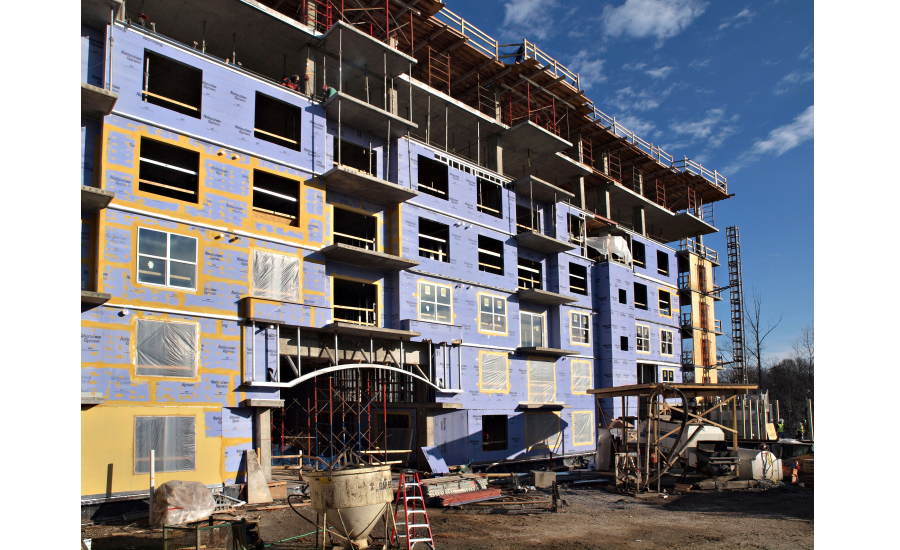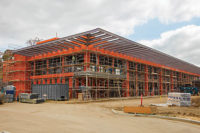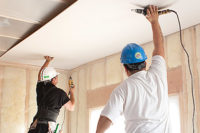In modern construction, there are a variety of exterior grades of sheathing. We used to have primarily the old paper-faced gypsum sheathing, commonly known as gyp-lap. It had sort of a tongue and groove edge and came in 2-feet by 4-feet sheets. The tongue side faced up and the groove side snuggled it to help control water infiltration because it was kind of a shingle style installation. The paper was completely sealed across the front with a seam around the back perimeter edges. It was difficult to not install it correctly but if I asked for a show of hands from those that have seen it installed wrong, mine wouldn’t be the only one in the air.
This sheathing was marketed as “moisture resistant.” It had a gypsum core but products with a paper face couldn’t withstand high levels of moisture over long periods of time. I may be mistaken but I believe it had an exposure rating of 45 days and had to be covered or replaced because the paper would start to turn loose. This created a hurdle for the EIFS industry early on. Even with a flawless EIFS installation, if there was bad detailing or interfacing with other components that allowed moisture in, the paper would delaminate from the gypsum core and the adhesively attached EIFS would turn loose. I have seen one or two gyp-lap installations over the last year or so but this product has been bred out by most designers because better products hit the market.
As we moved into the ’90s, glass-matted gypsum took over as preference when a gypsum-based product was desired or specified. It’s very difficult to peel the matting and I believe most manufacturers, after testing and tweaking the product, allow for a 12 month exposure rating. This was a big jump forward, especially with long duration projects and high-rise buildings that could not be covered in a month or so.
Types of Sheathing
Let’s start by introducing a new terminology for sheathing. Many manufacturers now refer to sheathing as wall panels. Today’s wall panel options are pretty broad but most, when used with stucco or EIFS, fall into one of three categories. We have structural wood panels (SWP), structural panels (SP) and gypsum panels (GP), which have little or no structural value. When shear value or structural value are required most designers chose structural wood panels. In cases of non-combustible construction and shear value is required many will specify structural panels. This type of sheathing is usually gypsum core panels with a sheet of light gauge metal laminated to it provide structural value. When engineering does not require an increase in structural value the glass matted GP are the choice over most others.
Structural wood panels are primarily plywood or OSB. These are engineered products that have strict manufacturing and auditing guidelines, especially APA stamped shear panels. Their performance record has many decades of a proven track record. We now have some other proprietary SWP coming to the market that has yet to prove themselves in real life conditions for the long term. Keep an eye on these for the latest independent tests and to insure you are getting what you think.
Going South
Gypsum panels, in my opinion, perform better behind stucco and EIFS. It is always installed horizontal, doesn’t swell when moisture is introduced and clearly has an outer face. EIMA requires all sheathing joints to be offset from the corners of openings when installing EIFS. Building codes do not because it is not an ASTM Standard, yet. I don’t know why. These are areas of concentrated stress.
In wood frame construction the preferred sheathing is SWP. When it’s used, diagonal bracing is not required on wall assemblies. This is a plus because it cuts down on labor and material costs. It also comes with some baggage, not the product, the installation. Most SWP have an inside and an outside face. Some are stamped for the direction of installation because the strength axis is on the horizontal installation. Many contend the shear value is not changed whether installed vertical or horizontal. Personally, wouldn’t you think that spanning seven studs with the panel horizontal would make for a stronger wall assembly than vertical? I certainly do.
APA SWP comes with another stamp that many times is in Spanish, as well as English. “Space 1/8-inch at edges and 1/8-inch at sides” but only a few take the extra second it takes to space them. This is a big no-no with SWP. They have a tremendous force for expansion if they get wet. If they can’t move lateral because they are butted tight they move outward from the stud cracking stucco.
Another issue with SWP is it has to be cut with a saw not a knife like GP. This increases labor costs especially when the installer has to cut it to offset the panel edge from a right angle opening, not to mention the waste of material. This creates a major issue for the stucco because you are actually weakening the corners not reinforcing them. The lath and cement do not have the restraining capacity to restrict the stress generated on the corners leading to cracks. Over driven fasteners brings with it more issues. The holding capabilities are decreased by overdriving nails. Hot dipped ring shank nails with a full head should be specified because common sense tells you it is best practice and testing supports this. Building codes do not require any of the above SWP related issues to be enforced; they are more concerned about nailing patterns.
Realistically, a prudent stucco contractor should bring these items to the attention of the builder prior to shear panel installation with a short site visit prior to starting the project or in a pre-construction meeting.
APA Recommendations for Shear Panels Behind Stucco
Have any of our readers, installers or designers ever reviewed this document? APA Document Q370G. This is an excerpt taken straight from its website. “Probably more important to the stucco exterior wall finish is the strength and stiffness on the wall in a direction perpendicular to the plane, such as when the wind is acting directly on the wall. The sheathing spanning between the studs must be strong and stiff enough to prevent cracking of the stucco when subjected to these loads. Wood structural panels, especially when installed horizontal with the edges blocked (between studs) are unsurpassed among code recognized wall sheathing products for providing the requisite strength and stiffness for such applications.”
The APA goes on to say when using SWP as a substrate for stucco “upgrade the usual specification to provide improved performance under the stucco exterior finish.” Who does this? Maybe high end or custom builders but no production builders will upgrade. They will choose 7/16-inch OSB every day of the week over 5/8- or 3/4-inch plywood. When you get down to the actual thickness of 7/16-inch SWP, it’s barely a red hair over 3/8-inch. Now we have stucco twice as thick than what is supporting it from wind loads. Something seems fishy here.
Pre-construction Meetings
In most commercial projects there is usually a pre-construction (pre-con) meeting prior to your start date. Sometimes just you and the designer with the GCs rep and other times with other trades that interface or impact your work will be there. It’s a very good idea to have these on all projects. If you pick up a contract, meet with the builder. Explain what you want or need for the best results in your systems. Talk about sheathing requirements, WRBs, membrane and metal flashing, dead loading the building, having the insulation and wall board installed prior to the stucco. This is good advice because if you move out of sequence and there are problems, (cracks etc.) you’ll be asked, “What happened to your stucco? You have cracks you need to fix.” It’s your responsibility to inspect the sheathing and substrate prior to starting your work. It is written in most specifications that once you accept the substrate it’s your baby. I don’t know why it’s our job to critique the framing and sheathing but its good practice especially when attaching EIFS with adhesive.
I was on an EIFS project several years ago with a tight schedule. My men were directed to start our installation. My foreman turned down the substrate because of inadequate fasteners. I received a mandatory directive to proceed. I went to the job and inspected it myself and I turned it down as well. I produced a document for spacing requirements from EIMA for screws. It took the framing contractor two days with three men to properly screw off the sheathing. If you show up to start your scope it’s in your best interest to make sure the substrate is ready. If SWPs are not spaced suggest the framer saw cut the joints, set the blade the depth of the sheathing to create a gap. Spacing is an installation requirement from the APA and every Technical Bureau I know of but it’s not code. SWPs are a great innovation in construction, but when installed improperly they can be stucco’s worst enemy. You have to do your part to be a prudent stucco contractor.
I feel part of my job when I write these pieces is to help educate the readers on best practices from a performance stand point because I’m at ground zero, they are anecdotal. I have seen the good, bad and ugly in stucco and sheathing installations. I won’t say I’ve never cut a corner and I know now that in the past I haven’t always walked the talk. I’ve been involved in stucco/EIFS installation for more than three decades. I am tuned in to changes in the industry to better my knowledge. We should all want the best results of our systems. Our industry is evolving.
Currently there is not a requirement for spacing gypsum panels. That may change in the future. Tests and studies have shown that even GP are subject to expansion and contraction. Not because of moisture but thermal variations. As minute as the movement is it has an impact on EIFS and can make the system buckle. As our industry evolves, tradesmen and project managers must evolve with it. Keep up to date, read technical publications. Get an annual ASTM book of Standards.





Report Abusive Comment